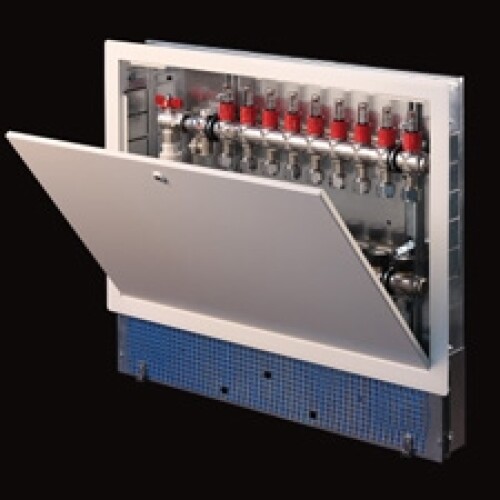Boxes for manifolds
Manifold cabinets: essential components for organisation and efficiency in hydronic systems
Manifold cabinets are fundamental elements in hydronic heating, ventilation, air conditioning, and refrigeration (HVAC/R) systems. These units are designed to house hydronic manifolds, facilitating the organisation, management, and maintenance of hydraulic circuits.
Choosing the right manifold cabinets is essential to ensure system efficiency, easy access, and component protection.
Types of manifold cabinets
- Recessed cabinets: Designed for wall installation, these cabinets offer a clean and discreet appearance, concealing manifolds and pipework within the building structure.
- Wall-mounted cabinets: Installed on the surface of walls, these cabinets are easy to install and provide quick access to the manifolds. They are ideal for applications where recessed installation is not feasible.
- Cabinets with doors: Equipped with a front door, these cabinets allow for easy access to the manifolds for maintenance and adjustments. The door can be lockable to ensure security.
- Insulated cabinets: Designed to minimise heat loss, these cabinets are thermally insulated, improving the energy efficiency of the hydronic system.
Innovations in manifold cabinets
Recent technological innovations have led to significant improvements in the performance and functionality of manifold cabinets, making them more efficient and versatile.
One of the key advancements is the use of advanced materials. The adoption of corrosion-resistant and impact-resistant materials has significantly increased the durability of these cabinets, improving their resistance to harsh environmental conditions. As a result, manifold cabinets last longer and maintain their performance even in challenging environments, reducing the need for frequent replacements and costly maintenance.
Modular design is another major advancement. Modular cabinets provide remarkable flexibility, allowing for easy expansion and system customisation. This means they can be adapted to the specific needs of each hydronic installation, making it easier to add new circuits or modify existing ones without replacing the entire unit. This feature is particularly useful in systems where requirements may change over time, offering a scalable and adaptable solution.
Another significant innovation is the integration of advanced insulating materials in the cabinets. This thermal insulation drastically reduces heat loss, improving the overall energy efficiency of the hydronic system. Maintaining a stable temperature inside the cabinets is crucial for system efficiency, and the use of high-performance insulating materials ensures that heat is not wasted, helping to reduce energy costs and optimise system performance.








